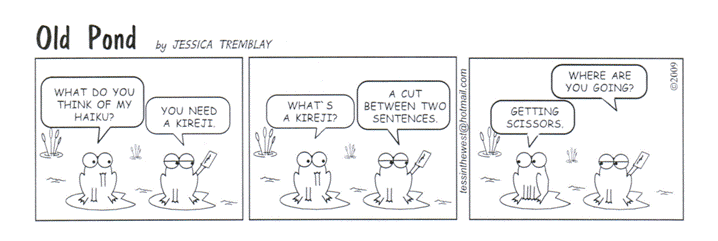はいくは何ですか?
古池や 蛙飛び込む 水のおと
- 芭蕉
Ancient pond –
A frog leaps in
The sound of the water
- Basho
日本語で、はいくは5−7−5音節(syllable, mora)に書きます。でも、日本語の単語(word)はだいたい長いです。だから、日本語の5−7−5は英語の5−7−5より短いそうです。さいきん、英語のはいくは5−7−5じゃなくてもいいです。
・季語 (Kigo: Season Word)
はいくを書く時、季語が重大(important)です。季語がはる、なつ、あき、ふゆと関係(relation)がある単語です。季語はたくさんありますが、むずかしいです。For example, in Basho's famous poem, kawazu (蛙: the frog) is a season word for spring. How are you supposed to know this? わかりません。季語を探す(look for) 時、さいじきをよみます。さいじき(歳時記)は季語のじしょです。
・切れ字 (Kireji: Cutting Word)
はいくだいたい切れ字があります。切れ字はむずかしすぎます。This is quite complicated, so I'd like to refer you to the Wikipedia page on this. However, the most important point for writing haiku in English is that there must be a a juxtaposition of two different images/topics – for example, the ancient pond, and the jumping frog (in this poem, the kireji is the particle や).
 |
| Found on Old Pond Comics – where (frog) Kaeru learns to write haikus from (also frog) Master Kawaku. |
リンクス:
NaHaiWriMo on Facebook: https://www.facebook.com/pages/NaHaiWriMo/108107262587697
Learn Haikus with Old Pond Comics (and two frogs): http://www.oldpondcomics.com/haiku.html
Online saishiki (one of many): http://etext.lib.virginia.edu/japanese/haiku/saijiki/brief.html
二月=にがつ (February – the second month)
一番=いちばん
短い=みじかい (to be short)
俳句=はいく
詩=し (poetry)
英語=えいご
目標=もくひょう (goal, target)
音節=おんせつ (syllable, mora
単語=たんご (vocabulary word)
長い=ながい (to be long)
重大=じゅうだい (important)
関係=かんけい (relation)
探す=さがす (to look for)
はいくはとてもおもしろいです。私はたぶんききます。ポーストが、ありがとうございます。
ReplyDelete